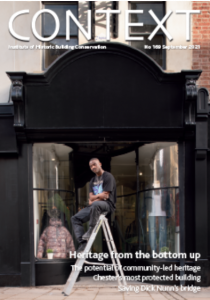 The new issue of the IHBC’s journal, Context No. 169, explores conservation led by the people, in particular communities’ historic infrastructure such as amenity societies, the contributions of which ‘will be more important than ever… as … rather than waiting, the voluntary sector will be working from the bottom up.’
The new issue of the IHBC’s journal, Context No. 169, explores conservation led by the people, in particular communities’ historic infrastructure such as amenity societies, the contributions of which ‘will be more important than ever… as … rather than waiting, the voluntary sector will be working from the bottom up.’
The IHBC writes:
Have you ever asked yourself why you are passionate about historic buildings (assuming that you have not devoted part of your life to conserving them because you could not think of anything else to do, or because your careers adviser suggested it, or because you failed your accountancy exams)?
Some will say that whenever they see historic buildings they can not help imagining what went in and around them long ago, and that makes life much more fun. Others may say that historic buildings convey the feelings of the people who commissioned, designed and built them, which gives the viewer or user a feeling of connection with people long gone who shaped the world around them.
… historic buildings and places have a special value in accommodating modern uses, and adapting successfully to changing circumstances…
There are other reasons too. Most historic buildings were handmade: their craftsmanship enables people to share the satisfaction, and perhaps joy, that the builders felt in expressing themselves, in making something useful, or in working with fine, natural materials. Historic buildings and their local styles, uses and materials create places that are unique, creating a sense of belonging or of being somewhere special. And historic buildings and places have a special value in accommodating modern uses, and adapting successfully to changing circumstances.
Those are only a few of the reasons to love historic buildings. Such feelings are shared not just by building conservation professionals, but by many other people. Many of them seek out historic buildings and places, and their lives are enriched by that. Others find more direct ways of expressing their enthusiasm as well: by campaigning to protect historic buildings and places, and by working within organisations devoted to finding new futures for them. This issue of Context focuses on some of the organisations – amenity societies among them – that are devoted to that sort of work.
… Matthew Saunders points out that a spirit of partnership between the government and the citizen has underpinned statutory listing since its introduction…
To mention just a few of our articles, David Tittle highlights the potential of the charities, community organisations and social enterprises – members of the Heritage Trust Network – whose role as heritage custodians is to rescue, restore and reuse historic buildings, structures and spaces. Matthew Saunders points out that a spirit of partnership between the government and the citizen has underpinned statutory listing since its introduction, and that the first stirrings of conservation in this country have been relentlessly bottom-up rather than top-down, with national government generally following the voluntary movement. Marcus Binney reminds us of how, over four decades, the campaigns of SAVE Britain’s Heritage have helped to shape national policy on conservation. Steven Robb describes the work of Scotland’s Town Partnership in supporting the historic environment’s role in regeneration and recovery.
At a time of recovery from the pandemic, and of urgent efforts to build a green economy and greener ways of living, the contribution of amenity societies will be more important than ever. Achieving their full potential will depend on, among other things, enhancing skills and resourcing local authorities. As ever, rather than waiting for that to happen, the voluntary sector will be working from the bottom up.
Themes articles include:
- The potential of community-led heritage – David Tittle
- Saving Dick Nunn’s bridge – Trevor Disley
- The joys of partnership – Matthew Saunders
- Four decades of SAVE campaigns – Marcus Binney
- This could be Chester’s most protected building – Tony Barton
- Working with Scotland’s Town Partnership – Steven Robb
- Aberdeenshire and the North East of Scotland Preservation Trust – Cheryl Roberts
- Wentworth Woodhouse: the people’s project – Sarah McLeod
- Churches and the amenity societies – Lisa McIntyre
- Kurt Schwitters in Elterwater Andrew Shepherd
Feature articles cover:
- The extensive urban survey 30 years on – Nicola Grayson
- Magdeburg Cathedral and a queen from England – Michael Asselmeyer
Regular features include:
- Briefing
- Out of Context
- Periodically
- The writer’s voice
- Editorial
- Notes from the chair
- Director’s cut
- New members
- Vox pop
- Book reviews
- New member profile
- Inter alia
Reading Context helps IHBC members develop their skills across all of the IHBC’s Areas of Competence, and so is a critical baseline in addressing priorities in Continuing Professional Development (CPD)
Access the online archive and see the issue online
See more IHBC background and guidance on IHBC CPD and on how you might use past, current and future issues of Context
See the formal guidance paper on IHBC CPD(scheduled for update)
See more on the IHBC Competences and Areas of Competence
Access the online archive and see the issue online

